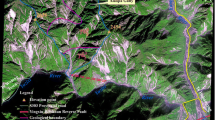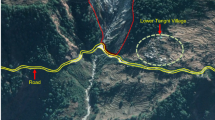Abstract
Debris flow often causes enormous loss to life and property, especially on alluvial fans. Engineering structures such as retention check dams are essential to reduce the damage. In hazard mitigation evaluation and planning it is of significance to determine the location, size and type of dam and the effects of damage mitigation. We present a numerical simulation method using Kanako simulator for hazard mitigation planning of debris flow disaster in Tanjutani Gully, Kyoto City, Japan. The simulations were carried out for three situations: 1) the simulations of erosion, deposition, hydrograph changing and inundation when there were no mitigation measures; 2) the simulations of check dams in four locations (470 m, 810 m, 1,210 m and 1,610 m from the upstream end) to identify the best location; 3) the simulations of check dams of three types (closed, slit and grid) to analyze their effects on sediment trapping and discharge reduction. Based on the simulations, it was concluded that two closed check dams (located at 470 m and 1,610 m from the upstream end) in the channel and a drainage channel on the alluvial fan can reduce the risk on the alluvial fan to an acceptable level.
Similar content being viewed by others
References
Fei XJ, Shu AP (2004) Movement Mechanism and Disaster Control for Debris Flow. Tsinghua University Press, Beijing (In Chinese).
Ikeya H (1989) Debris flow and its countermeasures in Japan. Bulletin of Engineering Geology and the Environment 40(1): 15–33.
Kyoto Civil Engineering Business Office and Wada Measuring and Design Office Co., Ltd. (2002). Tanjutani Gully Project Report. (In Japanese).
Kang ZC, Li ZF, Luo JT (2004) Research on Debris Flow in China. Science Press, Beijing. (In Chinese)
Liu JF, Nakatani K, Mizuyama T (2012) Effect assessment of debris flow mitigation works based on numerical simulation by using Kanako 2D. Landslides, DOI: 10.1007/s10346-012-0316-x. (Online)
Nakatani K, Wada T, Satofuka Y, Mizuyama T (2008) Development of “Kanako 2D (Ver.2.00),” a user-friendly one- and two-dimensional debris flow simulator equipped with a graphical user interface. International Journal of Erosion Control Engineering 1(2): 62–72.
Nakatani K, Satofuka Y, Mizuyama T (2007). Development of ‘KANAKO’, a Wide Use Debris Flow Simulator Equipped with GUI. Proceedings of the 32nd Congress of IAHR, Venice, Italy. CD-ROM, 10p, A2.c-182.
Satofuka Y, Mizuyama T (2005). Numerical simulation on a debris flow in a mountainous river with a Sabo dam. Journal of the Japan Society of Erosion Control Engineering, 58(1):14–19. (In Japanese with English abstract)
Satofuka Y, Mizuyama T (2006) Numerical Simulation of Debris Flow Control by a Grid Dam. Proceedings of the 6th Japan-Taiwan Joint Seminar on Natural Hazard Mitigation. (In CDROM)
Takahashi T, Yoshida H (1979) Study on the deposition of debris flow (1): deposition due to abrupt change of bed slope. Annuals of Disaster Prevention Research Institute, Kyoto University, 22: 315–328. (In Japanese with English abstract)
Takahashi T (1980) Study on the deposition of debris flow (2): process of formation of debris flow. Annuals of Disaster Prevention Research Institute, Kyoto University, 1980, 23:443–456. (In Japanese with English abstract)
Takahashi T, Nakagawa H (1991). Prediction of stony debris flow induced by severe rainfall. Journal of the Japan Society of Erosion Control Engineering, 44(3): 12–19. (In Japanese with English abstract)
Takahashi T, Nakagawa H, Satofuka Y, Kawaike K (2001) Flood and sediment disasters triggered by 1999 rainfall in Venezuela: A river restoration plan for an alluvial fan. Journal of Natural Disaster Science 23(2): 65–82.
Takahashi T (2007) Debris flow: Mechanics, Prediction and Countermeasures. Taylor & Francis, Leiden, The Netherlands.
Wada T, Satofuka Y, Mizuyama T (2008) Integration of 1-and 2-dimensional models for debris flow simulation. Journal of the Japan Society of Erosion Control Engineering 61(2): 36–40. (In Japanese with English abstract)
Author information
Authors and Affiliations
Rights and permissions
About this article
Cite this article
Liu, J., Nakatani, K. & Mizuyama, T. Hazard mitigation planning for debris flow based on numerical simulation using Kanako simulator. J. Mt. Sci. 9, 529–537 (2012). https://doi.org/10.1007/s11629-012-2225-9
Received:
Accepted:
Published:
Issue Date:
DOI: https://doi.org/10.1007/s11629-012-2225-9




